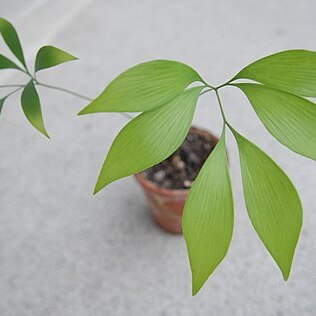Stem elongate, to 10 cm diam., with an elongate tuberous tap root, and 1–5 short, slender, leaf-and cone-bearing branches. Leaves 1–7 in the crown, erect, with 4–10 spreading branches (pinnae), 100–200 cm long, to 100 cm broad; petiole to 100 cm long. Pinnules 7–30 on each pinna, obliquely lanceolate, decurrent at base, 7–15 cm long, 1.5–4 cm broad, entire or a few with occasional coarse lacerations, rarely, regularly shortly serrate. Pollen cones stalked, ovoid, to 5 cm long, 2.5 cm diam.; sporophylls broadly cuneate, distally dilated and truncate. Female cones sessile, ovoid to globose, to 10 cm long, 10 cm diam.; sporophylls in about 8 ranks; expanded ends ±hexagonal, 30–55 mm wide, c. 15 mm tall. Seeds to 32 mm long, 18 mm wide.
More
A small cycad. It is a palm like plant. It grows 1.5 m tall and spreads 1.5 m wide. It has an underground trunk. This is carrot shaped and 12 cm across. The tap root forms a tuber. The leaves are feather-like and arch over. They are 1 m long. The leaves are twice divided. The leaflets are leathery and oval. The edges of the leaves are smooth. Plants are separately male and female. Male cones are oblong and female cones are round. Male cones are 3-6 cm long by 2-3 cm wide. Female cones are 10-12 cm long by 7-10 cm wide. They are barrel shaped and brownish-green. They occur in groups at ground level. The seeds are 2.5-3.5 cm long by 1.5-2 cm wide. They are oblong and cream or pink or purple.
A tropical plant. It suits tropical and subtropical regions. It grows in the highland rainforests in Queensland in Australia. It requires some shade. It grows to 700 m altitude in tropical Queensland in Australia. It suits hardiness zone 11-12. In the Cairns Botanical Gardens. Melbourne Botanical gardens.
More
Scattered in open situations in and around rainforest in north-eastern Queensland; at elevations up to 600 metres. A common understorey plant of the wetter rainforests and their margins at low to moderate elevations.
Grows in open situations in and around rainforest.


